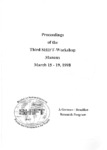Use este identificador para citar ou linkar para este item:
http://www.alice.cnptia.embrapa.br/alice/handle/doc/668401Registro completo de metadados
| Campo DC | Valor | Idioma |
|---|---|---|
| dc.contributor.author | NEVES, E. | pt_BR |
| dc.contributor.author | AZEVEDO, C. P. de | pt_BR |
| dc.contributor.author | GASPAROTTO, L. | pt_BR |
| dc.contributor.author | DUNISCH, O. | pt_BR |
| dc.contributor.author | BAUCH, J. | pt_BR |
| dc.date.accessioned | 2014-12-16T07:46:04Z | - |
| dc.date.available | 2014-12-16T07:46:04Z | - |
| dc.date.created | 1999-09-30 | pt_BR |
| dc.date.issued | 1998 | pt_BR |
| dc.identifier.citation | In: SHIFT - WORKSHOP, 3., 1998, Manaus. Proceedings... Bonn: BMBF, 1998. | pt_BR |
| dc.identifier.uri | http://www.alice.cnptia.embrapa.br/alice/handle/doc/668401 | pt_BR |
| dc.description | Establishment from a correlation between the nutrient content and the biomass of plantation trees. This was done in order to predict and to influence the wood quality to be expected already at an early growth stage. The development of biomass production of Ceiba pentandra (L.) Gaertn. (paineira) and Virola surinamensis (Rottb.) Warb. (ucuuba) was studied under monocultural conditions at an experimental field of Embrapa Amazonia Ocidental (Manaus-AM). Subsequently, the data were related to the nutrient supply after 45 and 46 months, respectively. It could be shown that the supply of the trees, especiallu with K and P, is restricted. The percentile content per dry weight biomass of the two macronutrients P and Mg deveases remarkably between 45 and 65 months of plant age. In addition, the recycling of P, K, Ca, Mg, and S from litter fall amounts to distinctly higher figues in paineira than in ucuuba. The fingings of the correlation between the biomass and nutrient content indicate the need of fertilization in order to guarantee sustainable growth of high quality wood species. | pt_BR |
| dc.language.iso | eng | eng |
| dc.rights | openAccess | eng |
| dc.subject | Especie florestal | pt_BR |
| dc.subject | Brasil | pt_BR |
| dc.subject | Amazonas | pt_BR |
| dc.subject | Manaus | pt_BR |
| dc.subject | Tropical rainforests | pt_BR |
| dc.subject | Fertilizers application | pt_BR |
| dc.title | Biomass production and nutrition aspects of plantation trees in Amazonia. | pt_BR |
| dc.type | Artigo em anais e proceedings | pt_BR |
| dc.date.updated | 2018-12-28T11:11:11Z | pt_BR |
| dc.subject.thesagro | Adubação | pt_BR |
| dc.subject.thesagro | Biomassa | pt_BR |
| dc.subject.thesagro | Fertilizante | pt_BR |
| dc.subject.thesagro | Floresta Tropical Úmida | pt_BR |
| dc.subject.thesagro | Planta Produtora de Madeira | pt_BR |
| dc.subject.thesagro | Nutrição | pt_BR |
| dc.subject.nalthesaurus | biomass | pt_BR |
| dc.subject.nalthesaurus | nutrition | pt_BR |
| dc.subject.nalthesaurus | woody plants | pt_BR |
| dc.format.extent2 | p. 413-418. | pt_BR |
| riaa.ainfo.id | 668401 | pt_BR |
| riaa.ainfo.lastupdate | 2018-12-28 -02:00:00 | pt_BR |
| dc.contributor.institution | CELSO PAULO DE AZEVEDO, CPAA | pt_BR |
| dc.contributor.institution | LUADIR GASPAROTTO, CPAA. | pt_BR |
| Aparece nas coleções: | Artigo em anais de congresso (CPAA)  | |
Arquivos associados a este item:
| Arquivo | Descrição | Tamanho | Formato | |
|---|---|---|---|---|
| Shift413.pdf | 4.91 MB | Adobe PDF |  Visualizar/Abrir |









